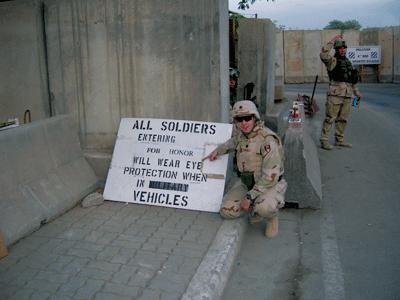 |
| Lt Col. Scott Barnes, MD, recently returned from a four-month tour in Iraq. |
With about 20 surgical specialties represented in Iraq at any given time, "great strides [are] being made every day in Iraq," Dr. Barnes says. The combat support hospitals offer the only medical services in the country, and medical personnel treat everything with a staff of fewer than 500 people. Cedars-Sinai Hospital in California, for example, has more than 12,000 employees, including 1,800 physicians. Still, the Army staff perform some 800 major surgical procedures per month.
Dr. Barnes' primary duty was to take care of the U.S. soldiers, but he did also treat U.S. contractors, Iraqi soldiers, civilians and even prisoners. He calls treating prisoners, former insurgents, a "strange" experience, knowing "that this person may have killed one of your U.S. comrades."
The Improvised Explosive Devices, or IEDs, the preferred weapons for insurgents during this military conflict, have increased a specific type of injury to soldiers as the weapons' frequency of use has escalated. A homemade IED has "metal fragments flying everywhere," penetrating the upper torso, neck, face and eyes, Dr. Barnes says.
Surgeons see three main types of penetrating eye injuries in Iraq, Dr. Barnes says: ruptured globes, periocular injuries to the eyelids and the loss of the eyelids or eye, with just a hole remaining. "There is nothing there anymore," he says. He also saw facial burn victims whose injuries included the eyelids. The ocular injuries he saw daily were worse than a trauma center in the United States sees with car accident or gun shot victims. Treating a soldier or civilian who has been injured by an IED is like treating a patient with multiple gunshot wounds, picking out each of hundreds of fragments of metal, dirt, granite, pebbles and grain from a patient's body and eyes. "It's just bits of dirt driven and wedged in their corneas," he says.
But body armor and equipment, including eye protection, have helped in this war to save the lives of U.S. soldiers, Dr. Barnes says. It is Iraqi civilians, lacking the body protection the soldiers have, who arrive at the hospital with more severe eye injuries. While the same or similar equipment was used in Desert Storm in the early 1990s, soldiers wear more armor now, and there is a stronger emphasis on eye protection, with commanders reminding soldiers to wear their protection when they go out. "The body armor and eye protection are doing their job," says Dr. Barnes.
Within minutes after arriving at the military hospital, numerous specialists gather to discuss the care needed for the patient, and which injury requires priority treatment. It is great for a doctor, Dr. Barnes says, to be able to consult easily with other specialists.
"This is not battlefield medicine," Dr. Barnes says, "but high-tech, world-class care. The soldiers know if they do get hurt, the medical system won't let them down."
Dr. Barnes sometimes felt as if he was back in medical school, cleaning injuries and stitching up patients when other surgeons and doctors were occupied elsewhere. Since he was the only ophthalmologist in the entire country at times, an obstetrician/gynecologist or even a urologist would assist him during surgeries, when an extra pair of hands was needed. "It was like residency all over again," says he.
Dr. Barnes had to work with an interpreter when treating his Iraqi patients. Dr. Barnes recalls the day one interpreter returned from work to find insurgents in his home, and was forced to watch as an insurgent put a gun to the temple of the interpreter's 9-year-old daughter and shot her. She lost an eye, Dr. Barnes said, but was fortunate to survive, thanks to him and a neurosurgeon who treated her. The hardest part for Dr. Barnes was treating the children. "They're attacking kids," he explains.
Dr. Barnes is now back in his position as chief of ophthalmology services at the Warfighter Refractive Eye Clinic at the Womack Army Medical Center, based at Fort Bragg, N.C. The center is one of several where soldiers, prior to leaving for Iraq, can receive laser eye surgery. The most common laser surgeries performed are PRK or LASEK. With the demands of contact lens hygiene and wear and tear to spectacles, those options aren't practical in the desert and dirt atmosphere, so thousands of soldiers have taken advantage of this program, inaugurated within the past few years.
Dr. Barnes is quick to credit the soldiers, the "everyday heroes, who sacrifice their lives" for what they believe in. What he does medically for the soldiers is the least he can do, he says. He calls his time in Iraq "incredible and the most horrible experience of my career at the same time. "The story's not me, it's those guys," he says. "I just did my job."
|
Lucentis Granted Priority Food and Drug Review
The Food and Drug Administration accepted the Genentech's Biologics License Application for the use of Lucentis (ranibizumab) in the treatment of neovascular age-related macular degeneration. As part of the BLA filing, Genentech requested and was granted a six-month Priority Review, intended for products considered to be potentially significant therapeutic advancements over approved therapies in the treatment, diagnosis or prevention of a disease. The FDA has until June 2006 to act on the filing.
Genentech also announced that preliminary two-year data from the Phase III MARINA study showed that the improvement in the Lucentis groups at year one was maintained at year two as measured by visual acuity endpoints, while there was further deterioration of vision among patients in the control group. The difference between mean VA in the Lucentis arms and the control arm increased at year two compared to year one. At least 90 percent of patients treated with Lucentis maintained (defined as a loss of less than 15 letters) or improved (defined as a gain of more than 15 letters) vision compared to about 53 percent of those treated in the control arm at year two [p<0.0001].
Consistent with year-one safety findings, common side effects that occurred more frequently in the Lucentis groups than in the control group at year two were mild to moderate and included conjunctival hemorrhage, increased intraocular pressure and vitreous floaters. Serious ocular adverse events in the MARINA study that occurred more frequently in the Lucentis-treated arms were uncommon and included endophthalmitis (cumulative 1.3 percent or less over two years) and intraocular inflammation (cumulative 1.7 percent or less over two years). For non-ocular serious adverse events, the combined cumulative rate of cerebral vascular events and myocardial infarctions at two years was 3 percent in the sham group, 4.6 percent in the 0.3-mg Lucentis group and 4.2 percent in the 0.5-mg group.
Genentech will submit two-year data from the Phase III MARINA study to the FDA. These data will be presented during May's Association for Research in Vision and Ophthalmology meeting.
The Lucentis BLA submission was based on one-year clinical efficacy and safety data from two pivotal Phase III trials, ANCHOR and MARINA, as well as one-year clinical data from the Phase I/II FOCUS trial. Data from these studies demonstrate that Lucentis is the first investigational therapy to have improved vision in patients with wet AMD in two pivotal Phase III clinical trials. In addition, Lucentis is the first investigational therapy to have demonstrated a clinical benefit compared to verteporfin photodynamic therapy in a head-to-head clinical study (ANCHOR).




